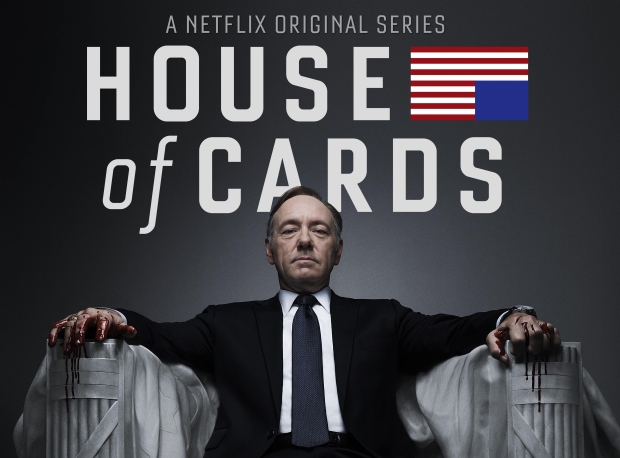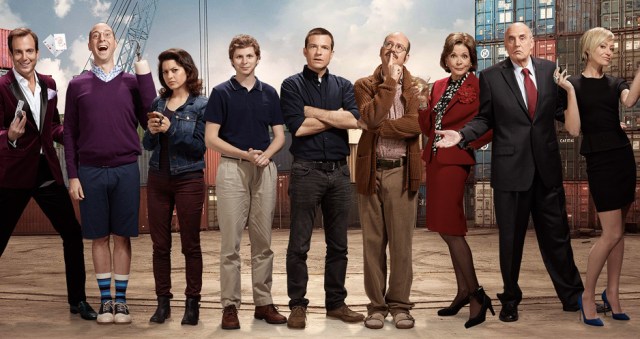The concept of watching a bunch of episodes of a TV show at once is either called ‘binge-watching’ or ‘marathoning’ the show. Those terms describe two ways of looking at something that’s becoming increasingly common thanks to DVDs, DVRs, and online streaming. Is it a binge? An ugly, messy, yet addictive experience in consumption? Or is it a marathon? A long, arduous undertaking that you’re proud of afterward? Netflix arguably shifted things further towards marathoning with the release of Arrested Development.
When Netflix dropped 13 episodes of its original series House of Cards at once in February, a lot of people concerned with the state of television wondered if the sky was falling, or if the emperor had no clothes, or if the fundamental model of series television was about to collapse like a… stack of bricks, or something. While in the past, binge-watchers have been stragglers and catch-ups, those who marathoned House of Cards would be the first to watch it. House of Cards creator Beau Willimon told the New York Times that shows on Netflix “might even dispense with episodes altogether” in the future. “You might just get eight straight hours or 10 straight hours, and you decide where to pause,” he said. As hard as it might be to imagine a TV show stripped of the familiar format of weekly episodes, anyone who’s ever binge-watched a show already knows what it’s like.

Binge-watching shows that were designed for weekly television inevitably leads to problems. Most obviously, all those suspenseful cliffhangers on Lost or 24 have all the drama sucked out of them when you jump to the next episode. And fans of a show are most engaged with it when they’re discussing it with their friends or with strangers on the Internet in that space between two episodes or the break between seasons. The fandom forms in that time between installments of your favorite show. And if you’re a binge-watcher who’s averse to spoilers, well, good luck. The Internet probably already ruined Game of Thrones for anyone who’s catching up. Sorry about that.
And yet I’ve heard people who refuse to get invested in following a show or a series of books in progress, because it doesn’t have a conclusion. To be fair, they have a point. They probably dodged a bullet when all the on-time watchers got hooked on all those serialized Lost clones that barely lasted a season. Are all those people who waited week after week for new episodes just suckers, or are the binge-watchers the ones who are missing out when they show up late for all the in-jokes and crazy speculation and water-cooler talk, or if they get spoiled on future plot points? Having heard some discussions about this, the arguments of the week-to-week watchers seem to reach dangerously close to “I was watching it before it was cool” territory. But while binge-watching old shows you missed is the only way of getting into that fandom, the idea of deliberately waiting until later to watch a show you could see now veers into the equally dreaded realm of fan entitlement.
While Netflix might seem like it’s diving straight into this conflict and making the divide between those who watched on time and those who caught up even worse, they might avoid it altogether by stepping away from the conventions of episodic TV in the first place. Cliffhangers, seasons, commercial breaks, exposition to remind people of past episodes, and even the length of episodes are elements that have been part of scripted television for decades, but they’re worthless to binge-watchers. So maybe Netflix’s shows should drop those TV-like elements and make an experience that doesn’t have to cater to week-to-week watchers.
But Netflix’s first few offerings, like House of Cards and the horror series Hemlock Grove, didn’t do much on that front. We shouldn’t really expect them to; they haven’t tried this before, and it’s easier to stay within what both the producers and the watchers are comfortable with.

Just over a month ago Netflix delivered the 15-episode fourth season of Arrested Development, a show long held up as one that was better watched in bulk due to the intricate plots, elaborate running gags, and overall niche value. The number of people that got into the show after its cancellation in 2006 was what made Netflix give it a second chance. And surprisingly, the new season seems to demonstrate the new format that media critics were looking for in Netflix’s original content strategy.
It focused around a different character every episode over the same period of time, which solves one problem of binge-watching: Episodes blurring together when you’re going through them rapidly. Its episodes were far longer than the 22 minutes of a broadcast sitcom, some reaching almost 40 minutes, and they varied in length as the creators saw fit. There were intersecting plots, running jokes, and background gags spread across multiple episodes that rewarded viewers who watched multiple episodes at once. Was it perfect? No, but it did the job well enough to show how Netflix originals could give a new start, as Tobias Fünke would say, to series television.
Netflix’s idea of “watch how you want” doesn’t necessarily mean watching it all at once, and some people have the self-control to watch one episode a week. But it’s hard to imagine a fandom abiding by a self-regulated watching schedule. Being part of an active fandom can add a huge amount of enjoyment and investment to a show, and that seems like a lot to lose. However, there’s a limit to how many hours of a show a production crew can make at once, so there will probably still be ‘seasons’ of some sort to give folks some breathing room.
And there’s one benefit that I think outweighs all the downsides. While networks make decisions based on unreliable Nielsen ratings, Netflix can track the exact numbers of what subscribers watch and market new shows accordingly. That could overcome the most frustrating thing about with Arrested Development and so many beloved-on-DVD shows: They so often get cancelled because they’re hard to get into and don’t always find their audience at first. That’s one element of the television industry that fans will almost certainly be glad to see gone.
(image via Flickr)
- If you’re going to wait for shows to end before watching them, check out our debate on what constitutes a spoiler
- DreamWorks is going to create 300 hours of content for Netflix
- Check out Adam WarRock’s Arrested Development season 4 rap-up







